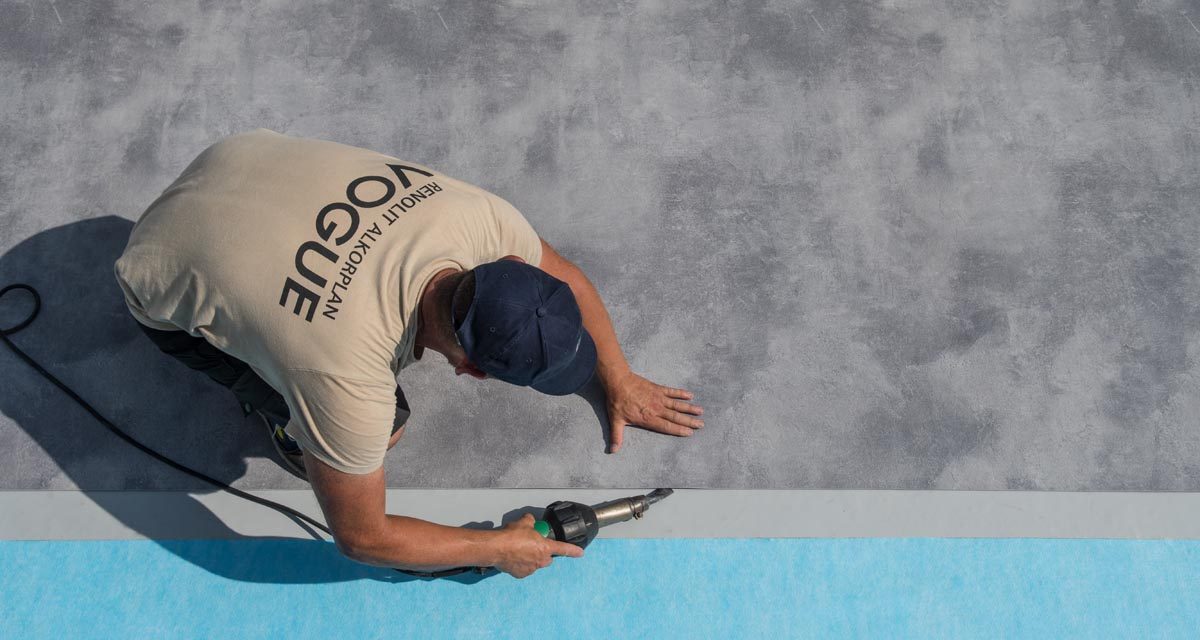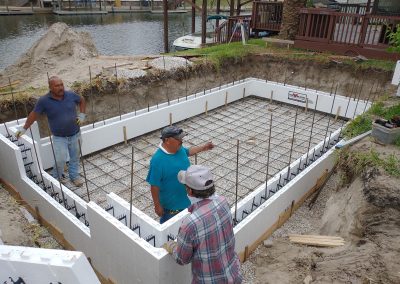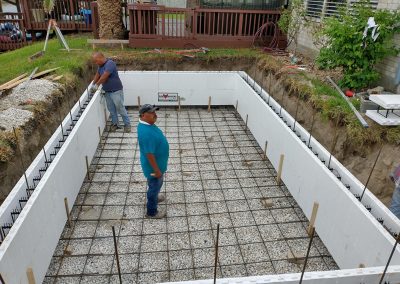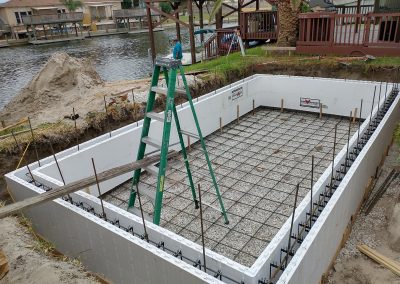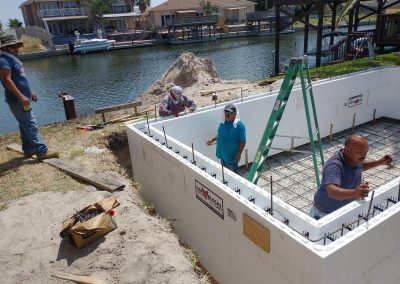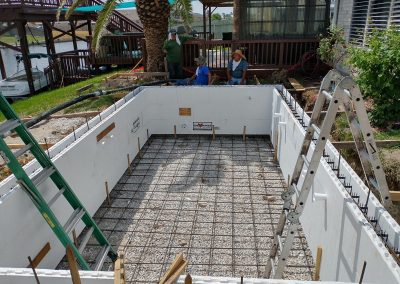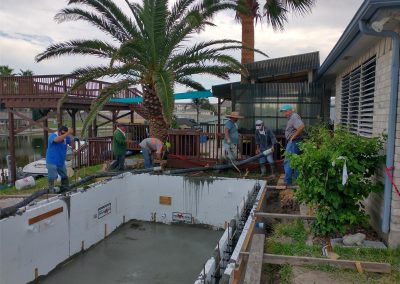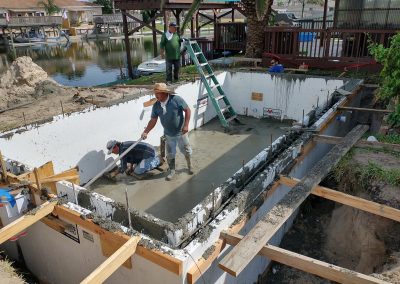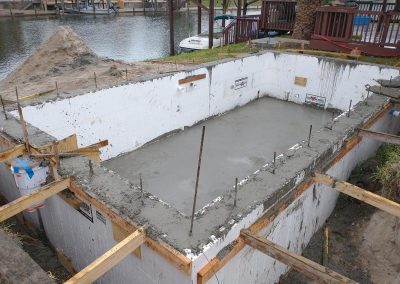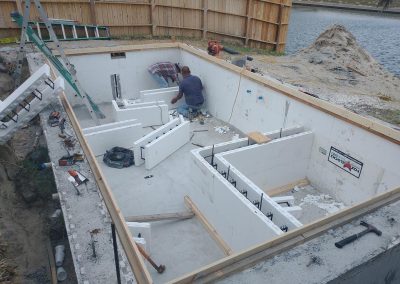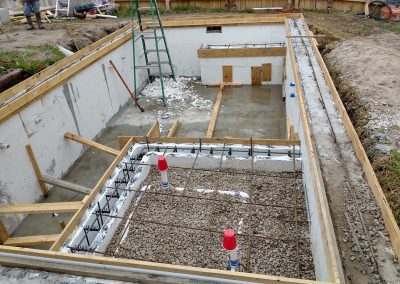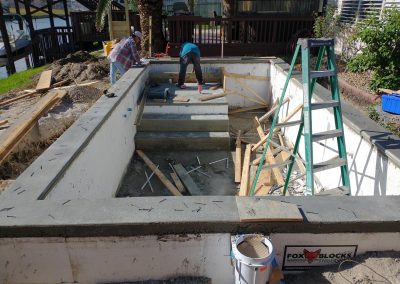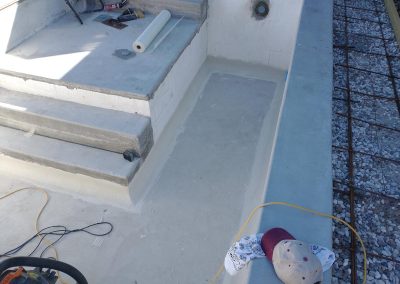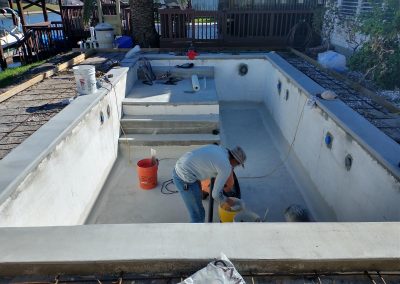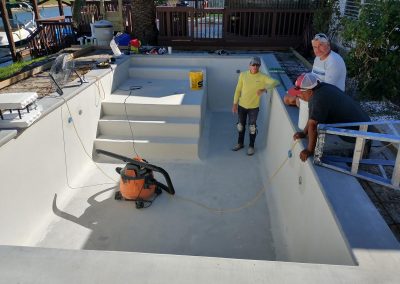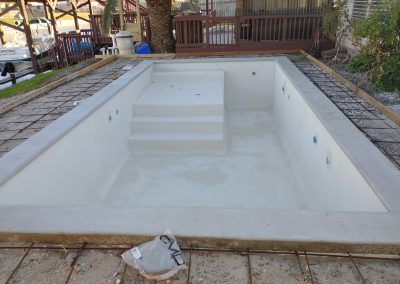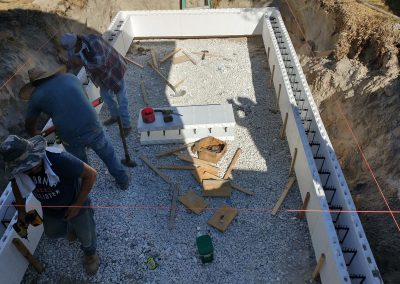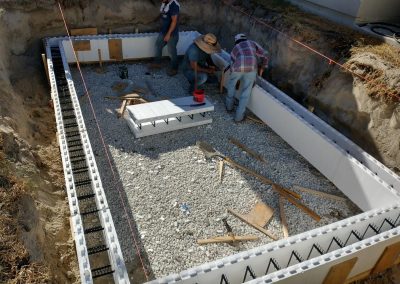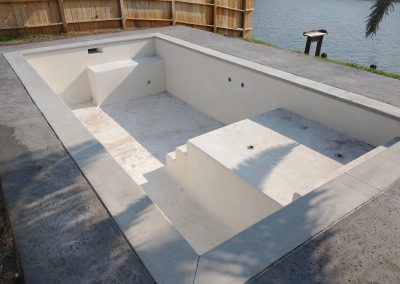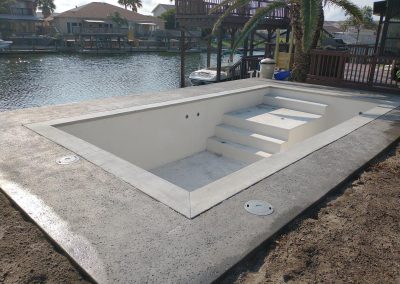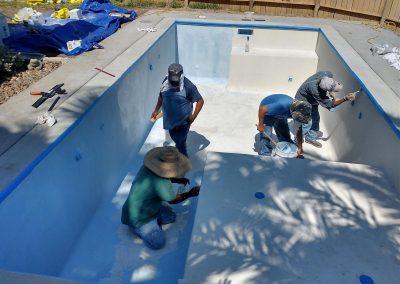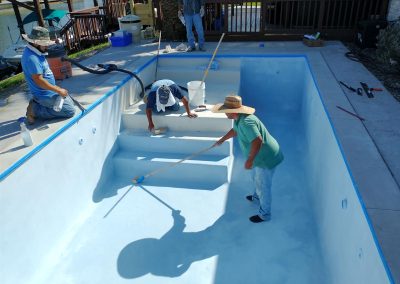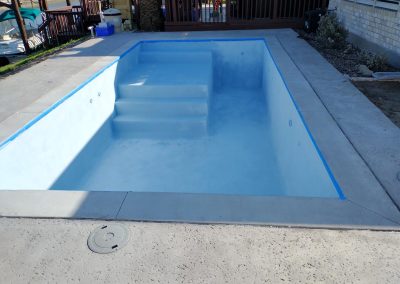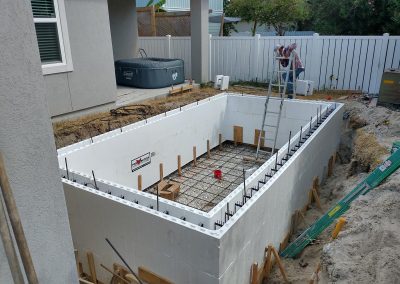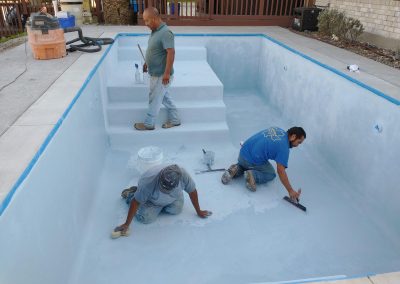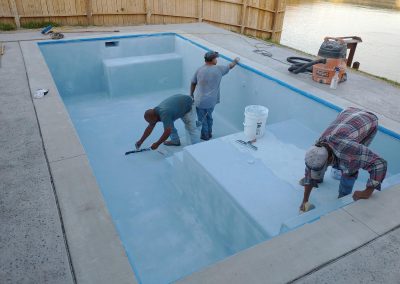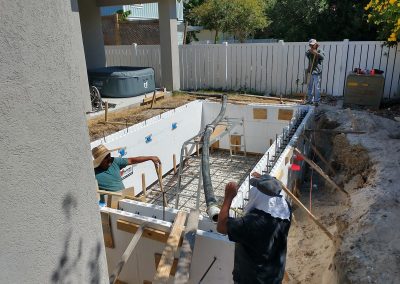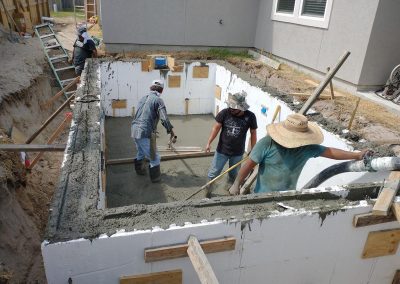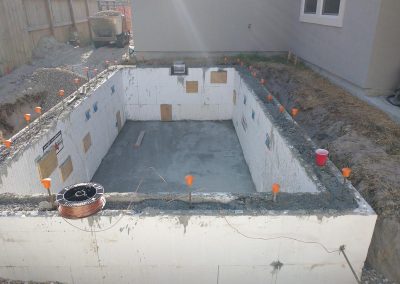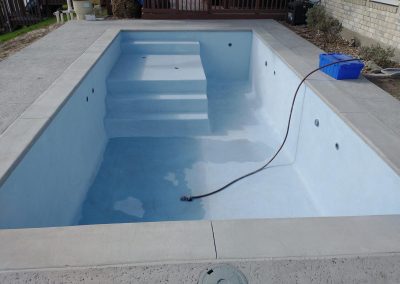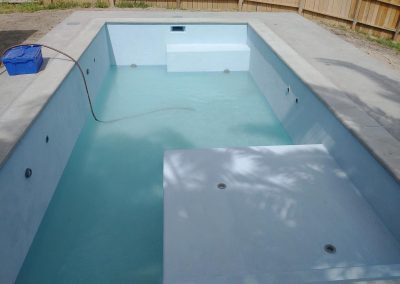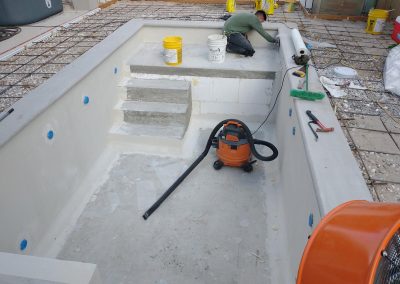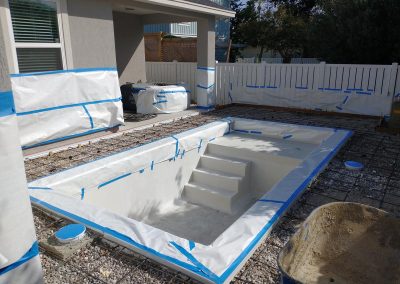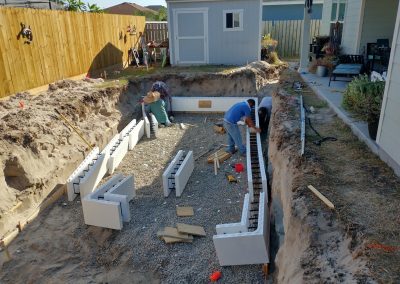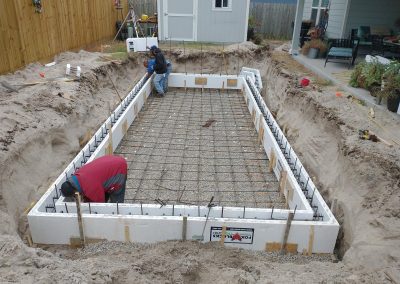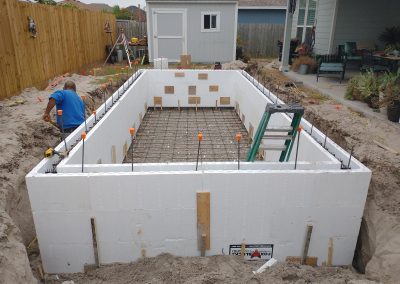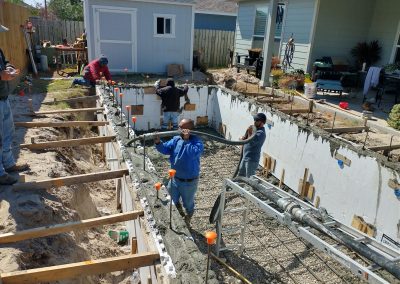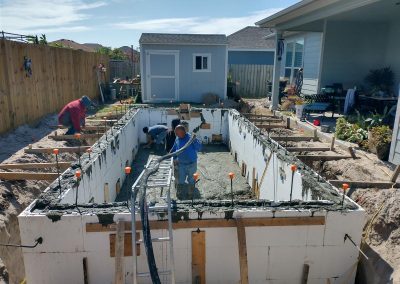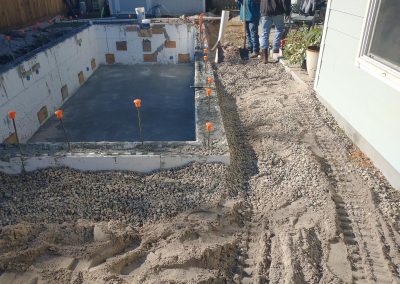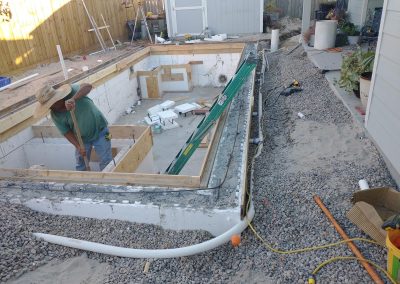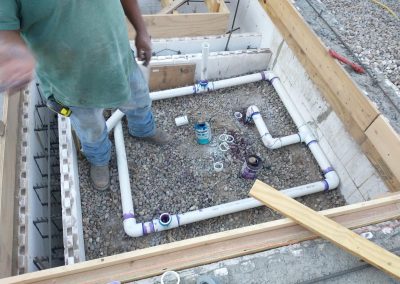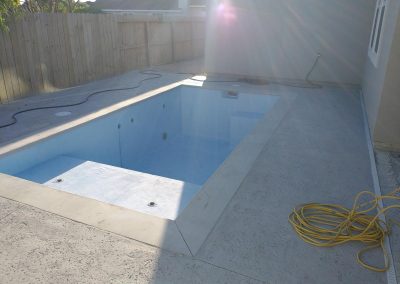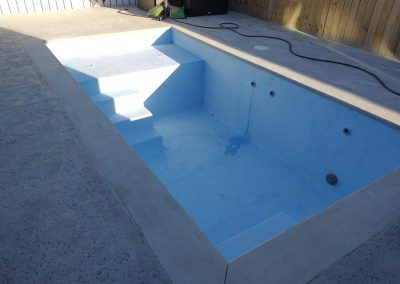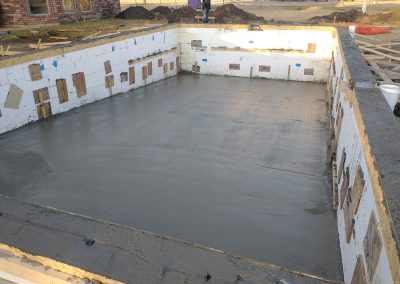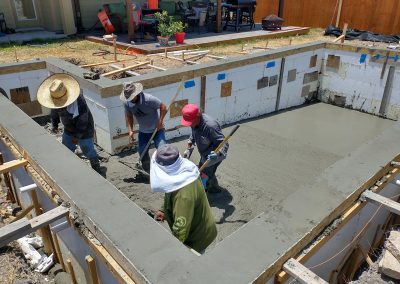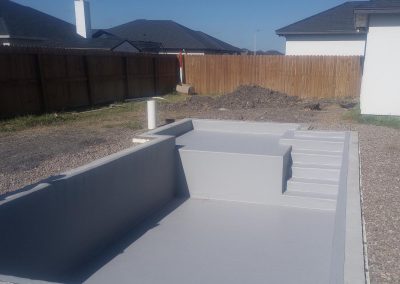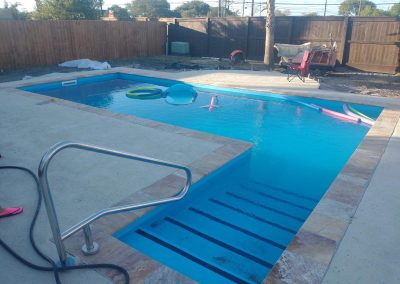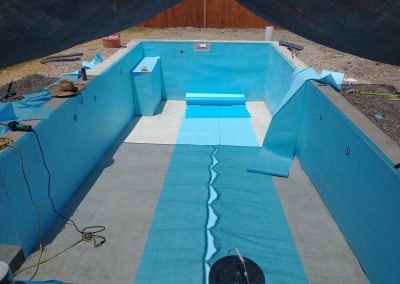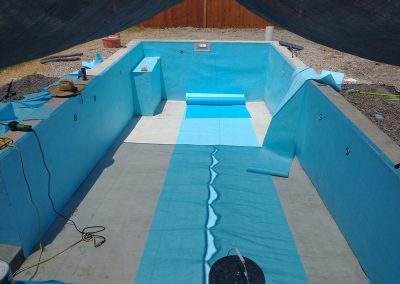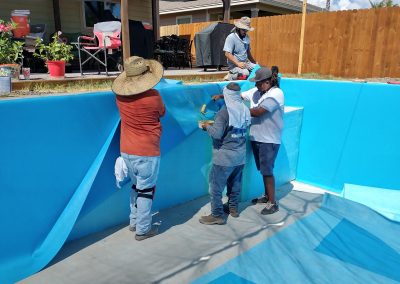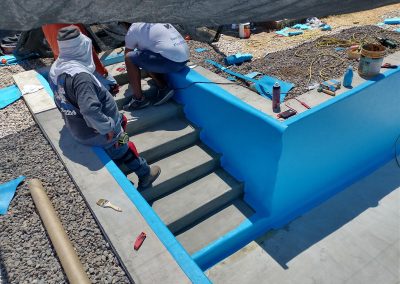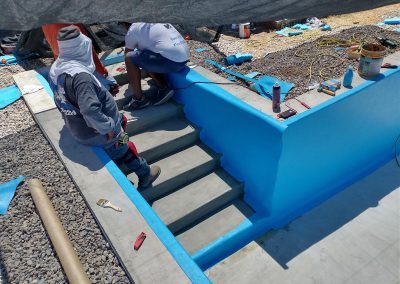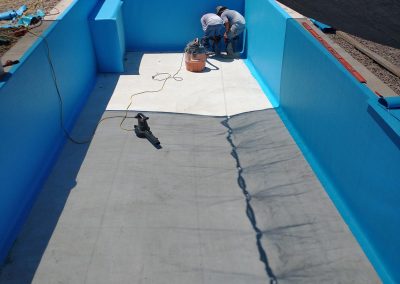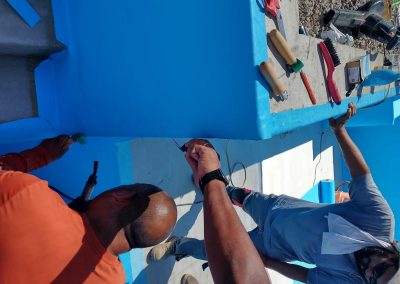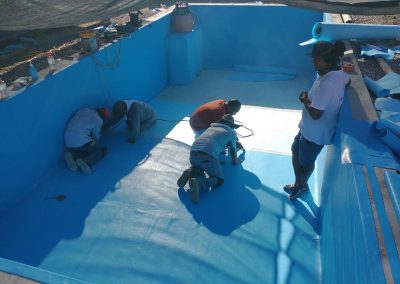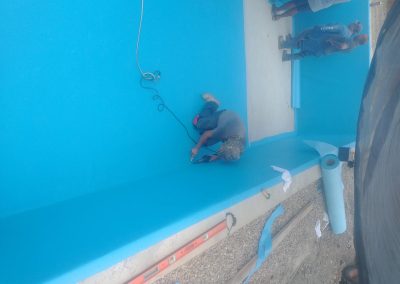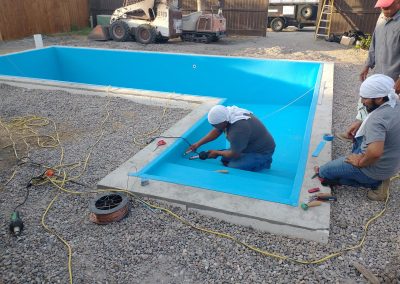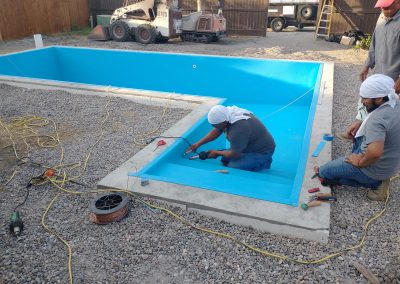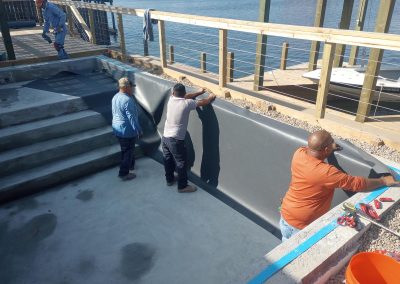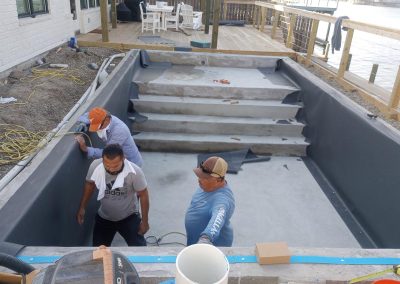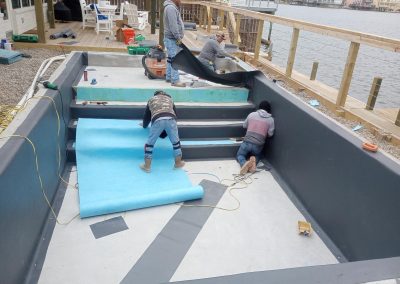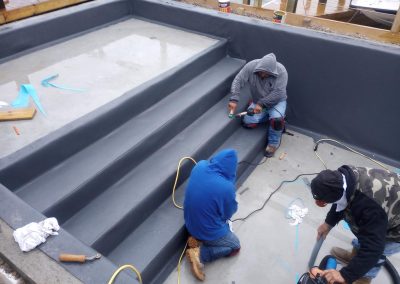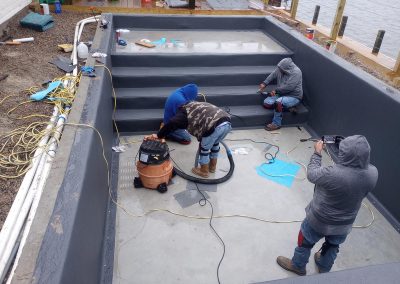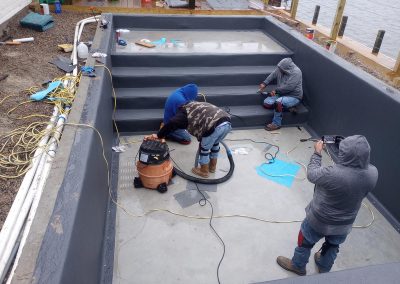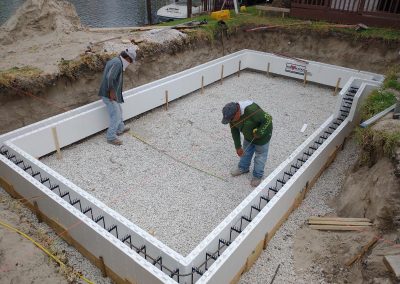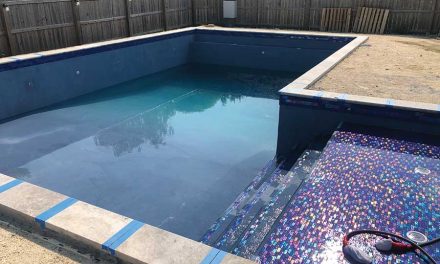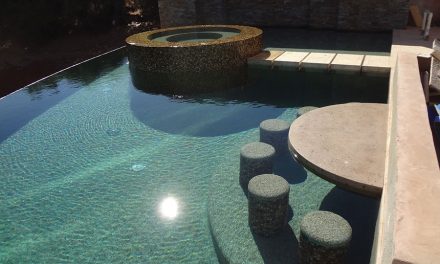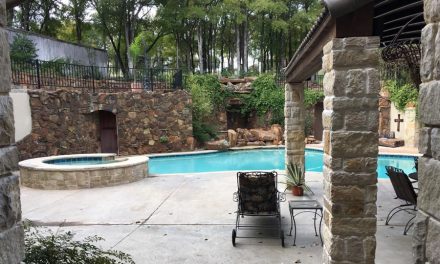It comes as no surprise then that there is a growing number of pool builders turning to insulated concrete forms (ICFs) with a polyvinyl chloride (PVC) membrane interior to create a solid concrete pool wall structure with a durable and attractive waterproofing solution that is welded onsite. Since these construction materials (foam forms and PVC membrane) are stocked and readily available, it enables builders to construct pools quickly and easily for any size yard with resort-style features that are in high demand.
The ICF system is newer to the pool industry but has been used in home building for many years. What has really helped boost the success of the system is the availability of new durable, attractive, and readily available PVC waterproofing membrane that has been a standard in Europe for decades. As a result, pool builders are currently integrating ICF methodologies into pool construction, specifically incorporating PVC membrane interiors. This integration facilitates the creation of custom pools while concurrently granting builders increased control over their construction timelines.
Understanding ICFs
ICFs consist of hollow blocks composed of expanded polystyrene foam and plastic bridges, or webbing, which serve the purpose of connecting the block sides. ICF systems have a long history of application in residential construction, particularly in the context of home foundations. This building technique relies on interlocking expanded polystyrene (EPS) foam blocks to establish a framework for reinforced concrete walls. These ICFs are systematically stacked atop each other and fortified with steel rebar. Subsequently, concrete is introduced into these forms, thereby generating a robust and enduring pool structure. Following the curing of the concrete, the forms remain in place, delivering superior insulation properties for the pool.
“When we started using ICF systems to build our pools, we were immediately attracted to the insulation properties of the product as it keeps the pool water warmer longer for our clients, which is especially beneficial here in northern Quebec,” says Max Lavio, owner of Aqua Max Plus in Gatineau, Quebec. “The ICF system is more energy-efficient, which can save customers money on their energy bills.”
The formwork includes internal webs that provide a continuous insulation layer to eliminate thermal bridging and air leaks. The foam blocks come in various sizes and shapes and can be easily cut and customized on-site to create virtually any pool design.
The foam blocks are engineered with interlocking features, creating a tight and secure formwork for the concrete. This formwork incorporates internal webs, ensuring a continuous insulation (ci) layer to eliminate thermal bridging and prevent air leakage. These foam blocks are available in various sizes and shapes, facilitating effortless on-site customization to create virtually any pool design.
“They are very versatile and allow us to customize each pool to the backyard, regardless of the property’s size or shape,” says Lavio.
ICF Construction Benefits
Amid the pandemic, numerous builders started investigating new construction options due to supply chain disruptions, which made building pools very challenging — especially as demand skyrocketed. Pool builders, in their quest for alternative construction options, sought systems that were readily available in inventory. This approach aimed to mitigate the challenges posed by construction scheduling uncertainties.
“The ICF blocks are readily available. We order and have the blocks in two days, delivered directly to the client’s location,” says Lavio.
Companies like Aqua Max Plus were also looking for construction solutions with benefits they could easily sell to consumers.
“One of the features we promote to our clients is the 51-mm, 2-inch foam within the concrete as it has insulating properties which helps the water stay warmer longer than traditional pool construction, which is a huge benefit in Canada where the swimming season is short as temperatures drop quickly,” says Lavio.
The built-in insulation incorporated within the ICF system serves to curtail heat loss and maintain pool temperatures, effectively insulating the pool’s interior from the colder soil surrounding the pool structure. Some manufacturers report the system can yield energy savings of up to 60% with respect to water heating costs. This advantage is further bolstered by the system’s expedited construction timeline. Since the ICF system is made with 6 inches (152 mm) of concrete, it is significantly stronger than other pool-building techniques.
Mark Teinert, owner of Pools by DC Design in Corpus Christi, Texas, says his company started working with concrete doing decorative pool decks and backyards 15 years ago but more recently started building pools.
“We have clay soil that shifts and moves and lots of water table issues, so I proactively chose the type of pool construction that could withstand these issues,” says Teinert. “We started with fibreglass pools but also built a few ICF pools to offer custom features since fiberglass didn’t allow for customization.
“Then, when Covid hit, we couldn’t get fiberglass pools, so we quickly shifted to building more ICF pools.”
Before the pandemic, Pools by DC Designs installed mostly fiberglass pools and a few ICF pools; however, the company has now shifted to mainly building the latter.
Since Teinert valued the fact that fiberglass pools are easy to maintain, he started looking for an interior waterproofing solution that offered the same ease of maintenance for his ICF pools. His company did try traditional vinyl liners but discovered the fabricated bag-style vinyl liner did not lend itself to the sharp corners of an ICF pool.
“I then discovered PVC membrane interiors, which have been used in Europe for decades,” says Teinert. “Once I did the research and completed the training with the manufacturer, I determined this was the perfect waterproofing interior product to pair with ICF pool construction.”
Pairing ICF With PVC Interior Membrane
The growing popularity of ICF pool construction can be attributed to the pandemic’s effect on the pool construction industry (both demand and supply chain shortages) along with the new PVC membrane offerings that are now readily available in Canada and the U.S. Pool builders have been known to use other finishing materials within the pool interior, but many of those require expensive upfront investments in equipment or are more difficult to maintain.
“We started with a plaster interior when we started building the ICF pool; however, plaster is a porous product and, as a result, it’s difficult for pool owners to maintain the water chemistry,” says Teinert. “There is always a migrating back and forth on the surface which can cause issues with the plaster as well as the water chemistry. Apart from the simplified maintenance advantages for pool owners, builders are appreciative of the immediate accessibility of PVC membrane rolls. These rolls can be procured without delay, with builders only needing to order the necessary quantity of rolls for each pool project. The longevity and high-quality of the 60-, 70-, and 80-mil reinforced PVC membrane material further pique the interest of consumers seeking a top-tier, robust, and long-lasting pool interior solution.”
Additionally, the introduction of new architectural finishes, along with an array of colors and textures, has quickly propelled these PVC membranes into the residential pool spotlight. Therefore, instruction and training concerning the correct installation procedures for PVC membrane are of utmost importance.
“It’s not hard to weld, but the training is important,” says Teinert. “It’s like wrapping the box from the inside out. It requires a lot of attention to detail so it’s important to take your time and not rush. Our team received manufacturer training and even assisted our initial installations to ensure we were doing everything correctly which helped cultivate a sense of confidence in our procedures.”
There is a learning curve, like anything else. However, pool professionals need to understand it is not that difficult and there is no need for expensive equipment.
“I found the heat gun to be intuitive, making the pool interior welding easy,” says Lavio. “But this winter, I will go to get more training to increase my speed and learn new techniques, tips, and tricks with corners, and other custom features on the pool to master the installation.”
Another main advantage of a reinforced PVC pool interior is it does not crack, regardless of freeze-thaw conditions or ground movement.
“A PVC membrane can be installed at 41 F (5 C), while a traditional vinyl liner needs to be installed ideally at a temperature of 59 F (15 C) so it can be stretched into place without wrinkles,” says Lavio. “Being able to install the PVC membrane in colder temperatures is very helpful for our company as we can build more pools later into the fall and winter, extending our construction season.”
The reinforced PVC completely seals the structure of the pool and keeps it watertight. This makes it ideal for both new pool construction as well as for pool renovations since the membrane can be placed over any pool surface.
“Even if there were to be a shift in the ground or a crack in the structure, the PVC membrane waterproofing isn’t affected so the pool won’t be destroyed, which provides a lot of peace of mind,” says Teinert.
The reinforced PVC membrane offers a unique, attractive waterproofing solution that also provides installers with a set of skills to keep crews busy through the winter, especially with indoor pools.
“When we started installing PVC membranes in pool interiors, we were using a traditional 30-mil manufactured liner on our ICF pools; then, one of our customers approached us saying he wanted something more durable,” says Lavio. “I had heard of thick PVC membrane interior for pools and worked with the manufacturer who helped with our first installation by providing on-site training. Once we did the first pool, we loved the product, and the client was happy with the result. As a company we decided that moving forward we would only offer the reinforced PVC membrane interior on our ICF pools.”
The reinforced PVC membrane takes center stage in the pool for consumers and the newer textures and natural stone look of the material is making it easy for pool builders to sell this waterproofing interior.
Customization and Convenience
By combining the ICF pool construction with the waterproofing weld-in-place reinforced PVC membrane interior, builders can create custom pools with a high-end, architectural look, even in small backyards.
“We are a specialty pool builder creating about a dozen, highly custom pools per year. We focus on quality and have one crew that stays focused on detail, creating unique pool designs customized for the client and their backyard — it is what distinguishes us from competitors,” says Teinert. “We do swim-up bars, sundecks, and resort pool features in smaller backyards.”
Even as backyards continue to get smaller in size, consumers are still interested in having resort-style features. The PVC membrane comes in textures, colors, and designs that make the pool look like it has a gunite, slate, or marble interior — but better because it is soft to the touch and easy on swimmers’ toes and feet.
“We get fabulous feedback from our clients who love how easy the interior is to clean, and how soft it is on their feet while looking very high-end in their backyard,” says Teinert. “We have hard water in our area, so we get calcium hardness build up, but this membrane is very easy to wipe down.”
Like the ICF blocks, the reinforced PVC membrane for the pool interior is readily available and shipped in rolls from stocking centres in Canada and the U.S., allowing builders to better control their construction schedules.
“We love the fact we can stock extra rolls at our shop to have on hand, especially with the popular designs and colors, so it’s in our shop and we can install immediately,” says Lavio.
Teinert agrees the integration of ICF construction and PVC membrane facilitates extensive design flexibility and customization, while maintaining ease of construction.
“This system enables us to perform all aspects internally, including excavation, formwork, concrete pouring, plumbing, interior membrane installation, and equipment setup,” says Teinert. “We prioritize control, as it sets us apart from local competitors.”
Lavio agrees and says they focus exclusively on constructing ICF pools due to the method’s ease, speed, and superior durability compared to steel and fibreglass pool construction.
“We used to build steel pools, but ICF is less expensive and more durable and is easier to customize especially with the PVC membrane interior,” he says. “We also do hotel and condo pools as the reinforced PVC membrane is also commercially rated and great to use in renovations, especially on big, older concrete pools.”
Strength and Waterproofing
The strength of ICFs combined with today’s designer reinforced PVC membrane waterproofing system is quickly becoming a mainstream concept that is gaining momentum among pool builders. ICFs allow builders to craft custom pools with resort-style amenities, expanding their market reach. These pools offer rapid construction, upscale features, esthetics, longevity, and low maintenance. The ICF and PVC membrane installation is straightforward, delivering cost-effective efficiency.
“This construction system is the perfect combination of strength and waterproofing, and I think it’s the next big thing that is going to take over the industry . . . it makes so much sense,” says Teinert.

